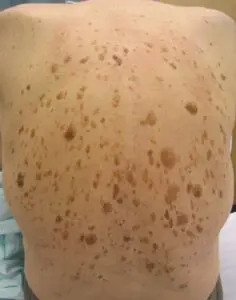These commonly occurring benign (non-cancerous) tumors are believed to be hereditary in nature (run in families). These tumors can appear anywhere on the body, but commonly occur on the face, breasts, back, arms, and legs. Occasionally, these keratosis can arise from solar lentigines (age spots or liver spots). These tumors may appear white, tan, or brown and can be smooth and waxy or can be rough and wart-like. Unlike melanomas, their borders are usually sharp and regular. For most persons, these tumors only pose a cosmetic concern. Occasionally, these tumors can itch and get irritated especially if they are at the waistline or braline (in women). These tumors frequently will change shape or color or even fall off, which usually is of no significance. Only rarely, will a squamous cell carcinoma (the second most common form of skin cancer) develop within one of these tumors.

NOTICE:
Under no circumstance will our office intentionally submit a claim using an incorrect diagnosis code to facilitate payment from an insurance carrier. This is considered insurance fraud! If the doctor believes that it is likely that your insurance carrier will not pay for the treatment/removal of these keratoses, you will be informed before the treatment and you will be personally responsible for payment if your carrier deems it not medically necessary. You may contact your insurance carrier if they have not paid for the service.
TREATMENT:
For most, removal of seborrheic keratosis is for cosmetic reasons only. In these circumstances, insurance carriers are not likely to pay for their removal. Occasionally, the removal of these tumors is considered medically necessary due to irritation (i.e. tumors at the waistline or braline). Medicare has strict criteria defining what instances the removal of these keratosis would be considered “medically necessary” and therefore paid for by Medicare.
These tumors can be frozen off using liquid nitrogen. This results in some discomfort during treatment and occasionally throbbing after treatment. After treatment a blister may form. Within several weeks (up to 5), the keratosis usually falls off. Occasionally a white or pink discoloration may result that can be permanent. Occasionally more than one treatment is needed.
These tumors can be scraped off. This leaves a raw area that may take days or weeks to heal and requires the application of an antibiotic ointment daily until completely healed over. A slight discoloration may result that can be permanent. Rarely, a second treatment is needed.
Irritated keratosis can be itchy. The use of a prescription strength corticosteroid cream or lotion is often effective in relieving any symptoms of itch and should only be used when needed (not daily). These creams and lotions will not make the keratosis go away, but may relieve the itching.
Come to our Deerfield Beach / Boca Raton office to have your Seborrheic Keratosis treated.
